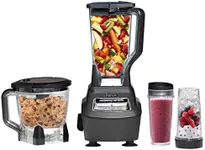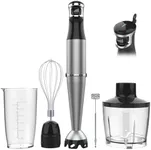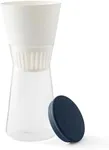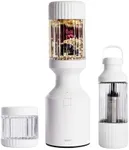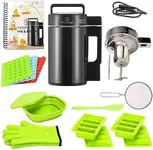Buying Guide for the Best Blender For Kitchen Mixer
Choosing the right blender for your kitchen can make a big difference in your cooking and food preparation experience. A good blender can help you make smoothies, soups, sauces, and even crush ice. To find the best blender for your needs, it's important to understand the key specifications and how they relate to your cooking habits and preferences.Power (Wattage)Power, measured in watts, indicates the strength of the blender's motor. Higher wattage means the blender can handle tougher ingredients and blend them more smoothly. Blenders typically range from 300 to 1500 watts. For simple tasks like making smoothies or blending soft fruits, a blender with 300-600 watts is sufficient. For more demanding tasks like crushing ice or blending tough vegetables, look for a blender with 700-1000 watts or more. Choose a blender with the right power based on what you plan to blend most often.
CapacityCapacity refers to the volume of the blender jar, usually measured in liters or cups. This determines how much you can blend at once. Blenders come in various sizes, from personal blenders with 0.5 liters (2 cups) to large family-sized blenders with 2 liters (8 cups) or more. If you usually prepare single servings or small batches, a smaller capacity blender will be more convenient. For larger families or batch cooking, a blender with a larger capacity is ideal.
Speed SettingsSpeed settings allow you to control the blending process. Blenders can have anywhere from 2 to 10 or more speed settings. Basic blenders often have low and high speeds, while more advanced models offer multiple speeds and pre-programmed settings for specific tasks like smoothies, ice crushing, or soup making. If you need versatility and precision, choose a blender with multiple speed settings. For straightforward blending tasks, a blender with fewer speeds will suffice.
Blade Material and DesignThe blades are crucial for effective blending. Most blender blades are made of stainless steel, which is durable and resistant to rust. The design of the blades, such as their shape and sharpness, also affects performance. Some blenders have multi-tiered blades for better blending efficiency. If you plan to blend hard ingredients or ice, look for blenders with strong, sharp blades. For softer ingredients, standard blades will work well.
Jar MaterialBlender jars can be made from glass, plastic, or stainless steel. Glass jars are heavy and durable, and they don't retain odors or stains. Plastic jars are lightweight and less likely to break, but they can scratch and absorb odors over time. Stainless steel jars are very durable and often used in high-end blenders, but you can't see the contents while blending. Choose the jar material based on your preference for durability, weight, and ease of cleaning.
Ease of CleaningCleaning a blender can be a hassle, so it's important to consider how easy it is to clean. Some blenders have dishwasher-safe parts, while others require hand washing. Look for blenders with removable blades and jars that are easy to disassemble and clean. If you use your blender frequently, ease of cleaning will save you time and effort.
Noise LevelBlenders can be noisy, especially those with powerful motors. If noise is a concern for you, look for blenders that are designed to operate more quietly. Some models have noise-reducing features or are specifically marketed as quiet blenders. Consider where and when you'll be using the blender to determine how important noise level is for you.
Additional FeaturesSome blenders come with additional features like pre-programmed settings, pulse function, or accessories like travel cups and food processor attachments. These features can add convenience and versatility to your blender. Think about which additional features would be useful for your cooking habits and choose a blender that offers those options.




